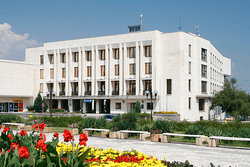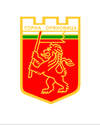Gorna Oryahovitsa
| Gorna Oryahovitsa Горна Оряховица | ||
|---|---|---|
| Town | ||
|
Gorna Oryahovitsa town centre | ||
| ||
 Gorna Oryahovitsa Location of Gorna Oryahovitsa | ||
| Coordinates: 43°08′N 25°42′E / 43.133°N 25.700°ECoordinates: 43°08′N 25°42′E / 43.133°N 25.700°E | ||
| Country | Bulgaria | |
| Province (Oblast) | Veliko Tarnovo | |
| Municipality | Gorna Oryahovitsa | |
| Government | ||
| • Mayor | Dobromir Dobrev | |
| Area | ||
| • Total | 21.108 km2 (8.150 sq mi) | |
| Elevation | 140 m (460 ft) | |
| Population (2009-12-31)[1][2][3] | ||
| • Total | 32,436 | |
| • Density | 1,500/km2 (4,000/sq mi) | |
| Time zone | EET (UTC+2) | |
| • Summer (DST) | EEST (UTC+3) | |
| Postal Code | 5100 | |
| Area code(s) | 0618 | |
| Website | Official website | |
Gorna Oryahovitsa (Bulgarian: Горна Оряховица) is a town in northern Bulgaria, situated in Veliko Tarnovo Province, not far from the city of Veliko Tarnovo. It is the administrative centre of the homonymous Gorna Oryahovitsa Municipality. As of December 2009, the town has a population of 32,436 inhabitants.[1][2][3]
The nearby village of Arbanasi is an architectural reserve with a large number of historical monuments, such as medieval churches and examples of the Bulgarian National Revival architecture.
History
Early history
The first settlement in the area dates back to the second half of the 5th millennium BC (Middle Neolithic Age). There are traces of a later Thracian settlement between the Kamaka (The Stone) Hill and the Arbanasi Plateau. Its inhabitants were from the tribe of Krobizi. They erected the Kamaka Fortress that existed from the 5th century BC to the 1st century BC, when the Romans built up their own fortified settlement over its ruins. It gradually acquired economic power mainly through cultivating grapes and producing wine. The life of that settlement continued up to the coming of the Slavs (6th–7th century). There is no substantial evidence of settled life between the 7th and the 12th century.
Middle Ages
After the restoration of the Bulgarian State at the end of the 12th century, a need arose for protection of the new metropolis Tarnovgrad. Several fortresses were built, including Rahovets (4 kilometres (2 miles) northwest of the modern town). The main purpose of the strongholds was to protect the roads leading to the Bulgarian capital Tarnovgrad. The name Rahovets means 'road fortress' (from Persian rah, meaning 'road'). The medieval fortress gave its name to the modern town, even though with some Slavic twist. They were well known for their mushroom farming at the time. This proved to be a good method of income for the town.
During the Ottoman invasion, the fortress was conquered by the Ottomans after its water pipeline was cut off (without destroying the fortress). Rahovets existed up to the year 1444 when King Władysław Warneńczyk during his campaign against the Ottomans destroyed it. Three individual small villages existed during the first centuries of Ottoman rule there—Mala (Little), Sredna (Middle) and Golyama (Greater) Rahovitsa. It was known as "Yukarı Rahova" ("Upper Rahovets" in Turkish) during Ottoman rule.
Development and growth
During the Bulgarian National Revival, Gorna Oryahovitsa gradually turned into an economically strong settlement. Crafts prospered and trade was among the most active in Northern Bulgaria. Every Friday there was a big market for cattle, agricultural production, timber, and charcoal. As early as 1822, a monastery school was opened here and in 1827 a private school that became public in 1835 began functioning. In 1850, the first girls' school opened gates and in 1859 the first intermediate high school was founded. A chitalishte (library and community centre) was opened in 1869. Gorna Oryahovitsa was proclaimed a town in 1870, when it numbered 4,700 inhabitants and had 1,200 houses and 5 churches.
Revolutionary struggles
The population of the town took part in the struggle for national liberation. Vasil Levski organised a revolutionary committee in Gorna Oryahovitsa during the first half of 1869 and later visited the town two more times. During the preparation of the April Uprising Gorna Oryahovitsa was designated as a centre of the First Revolutionary District with Stefan Stambolov as Chief Apostle. After the failure of the April Uprising, Georgi Izmirliev "Makedoncheto" (the Macedonian), one of the local leaders, was hanged in the centre of Gorna Oryahovitsa. His last words were: "How good it is to die for the freedom of the Fatherland!" Three citizens of Gorna Oryahovitsa fought in Hristo Botev's detachment of armed volunteers and 132 people joined the Bulgarian volunteer forces during the Russo-Turkish War of Liberation. The Imperial Russian Army liberated Gorna Oryahovitsa from Ottoman rule on 26 June 1877.
Liberated Bulgaria
After the Liberation, the town developed as a significant transport (predominantly railway) centre as it is nowadays. Its proximity with the old metropolitan town of Veliko Tarnovo, tourist centre Arbanasi, the monasteries around and a great number of other sites of interest makes it a known tourist destination.
Population
| Gorna Oryahovitsa | |||||||||||||||
|---|---|---|---|---|---|---|---|---|---|---|---|---|---|---|---|
| Year | 1887 | 1910 | 1934 | 1946 | 1956 | 1965 | 1975 | 1985 | 1992 | 2001 | 2005 | 2009 | 2011 | 2013 | |
| Population | 5,689 | 7,117 | 8,793 | 10,488 | 18,863 | 26,299 | 34,181 | 40,704 | 38,914 | 35,621 | 33,804 | 32,436 | ?? | ?? | |
| Highest number ?? in ?? | |||||||||||||||
| Sources: National Statistical Institute,[1] „citypopulation.de“,[2] „pop-stat.mashke.org“,[3] Bulgarian Academy of Sciences[4] | |||||||||||||||
Culture
- Communication center "Nadezhda 1869"

Education
- OU "Ivan Vazov"
- OU "Saint Kiril and Metodii"
- OU "Paisii Hilendarski"
- SOU "Vicho Grancharov"
- SOU "Georgi Izmirliev"
- M. V. Lomonosov School of Electrotechnics and Electronics
- PGT "Vasil Levski" (mechanics)
- PGLPI "Atanas Burov"
- PGHT "Prof d-r Asen Zlatarov" (food)
- PGJPT "N. J. Vapcarov"
Religion
Around 85% of the citizens are Christians.
- Orthodox Churche "Sveti Atanas" (Saint Atanas)
- Orthodox Churche "Sveti Georgi" (Saint Georgi)
- Orthodox Churche "Sveti Ivan Rilski" (Saint Ivan Rilski)
- Orthodox Churche "Sveti Nikola" (Saint Nikola)
- Orthodox Churche "Sveta Troitza" (Trinity)
- Orthodox Churche "Uspenie Bogorodichno"
- Orthodox Churche "Sveti Prorok Iliya" (St. Prophet Iliya)
Sights
- Hill Kamaka ("Hill the rock" in English)
- hut Bojur(place in the area around the town good for rest and walks)
Economy
Gorna Oryahovitsa is an important producer of sugar and sugar products in Bulgaria. Apart from the major sugar factory Sugar Plants Ltd. the town also has numerous smaller firms producing sweets and pastries.
- Sugar factory "Zaharni Zavodi—Gorna Oryahovitsa"
The company was founded in 1912. The company had her own thermal power plant. In the beginning, the company produced sugar confectionery, ethanol and high protein feed printing and other confectionery for the needs of food industry. In 1913 were constructed a new factory for sugar for sugar beet processing. The company made commercial relationships with other factories in Bulgaria and other countries in the Balkans. In the factory area in 1923 were built a place for alcohol range. In 1948 all factories property of "Bulgarian-Czech joint stock company for sugar industry" passed in the hands of People's Republic of Bulgaria. In the years of socialism the company continued its development, buying new machines and make new units for the different products which were exported for Bulgaria, Balkans, USSR, Turkey and other countries. For the workers had transport buses (Chavdar and Setra) and for excursions one or twice of the year for the workers. On 2000 the company is privatized. In the 21st century were built new factories and reconstruction of the factory and management. Today in the factory works around 800 people and the company is in the Sofia Stock Exchange.
- Skladova Tehnika AD is one of the biggest manufacturers of Solid Fuel Appliences,Hoisting Equipment,lifting platforms and cranes.The company is founded in 1916 and in the time of the People's Republic of Bulgaria the company exported their products in USSR, Romania,other socialist countries and countries from Asia and Africa.The cookers "Rahovec" are one of the most popular electrical Appliences in Bulgaria in 70s,80s and 90s and popular Bulgarian product outside Bulgaria.
- Bultraf EOOD is one of the biggest manufacturer of different types of transformers in North Bulgaria.The company was founded in 2004.
- Day and Nights sweets is a company for sweets in the town and one of the biggest manufacturers in Veliko Tarnovo province.
Town partnerships
Gorna Oryahovitsa maintains partnership links with the following places:
 Szigetszentmiklós, Hungary
Szigetszentmiklós, Hungary Cherepovets, Vologda Oblast, Russia
Cherepovets, Vologda Oblast, Russia Myrhorod, Poltava Oblast, Ukraine
Myrhorod, Poltava Oblast, Ukraine Waren an der Müritz, Mecklenburg-Vorpommern, Germany
Waren an der Müritz, Mecklenburg-Vorpommern, Germany Roșiorii de Vede, Romania
Roșiorii de Vede, Romania
Culture
During the last 15 years, Gorna Oryahovitsa has been developing an intensive festive activity. Some of the major yearly events are:
- Festival of Bulgarian culture and the Cyrillic script—24 and 25 May
- Festival of Gorna Oryahovitsa—28 May
- Golden Lion International Arm wrestling Tournament—28 May
- International Festival of Tourist Songs—3–5 June
- International Folklore Festival (children)—12–18 June
- International Folklore Festival (adults)—1–6 August
- Petropavlovski (St. Peter and Paul) National Folklore Festival
Sport
The town has a well-developed sport centre as the major sports practised are: football, basketball, arm Wrestling, gymnastics, badminton, athletics, Wrestling, sambo. In 1935 in Gorna Oryahovitsa were created Sport club Nikola Petrov. Later the club were renamed to SC Borislav. In 1949 in the neighborhood Kaltinets were build a stadium....
FC Lokomotiv Gorna Oryahovitsa
FC Lokomotiv Gorna Oryahovitsa were established in 1932. In 1935 in the North part of the town were created the first stadium "Unak". In 1963/1964 the club plays on Bulgarian first league.[5]
Transport

Gorna Oryahovitsa is a major railway junction in northern Bulgaria. In the town is one of the six international airports in Bulgaria—Gorna Oryahovitsa Airport, with flight to or from Sofia taking about 30 minutes.

Distances from Gorna Oryahovitsa:
- to Sofia—230 km
- to Varna—220 km
- to Rousse—100 km
- to Veliko Tarnovo (through Arbanasi)—7 km
Notable citizens
- Atanas Burov—banker and politician
- Nikola Petroff—wrestler
- Tsvetan Gashevski—arm wrestler
- Valeri Bojinov, footballer
References
- Notes
- 1 2 3 (in English) Bulgarian National Statistical Institute – towns in 2009
- 1 2 3 (in English) "WorldCityPopulation"
- 1 2 3 "pop-stat.mashke.org"
- ↑ (in Bulgarian) Bulgarian Academy of Sciences Archived 2011-07-06 at the Wayback Machine.
- ↑ FC Lokomotiv Gorna Oryahovitsa
External links
- Informative site about Gorna Oryahovitsa (in Bulgarian)
- Gorna Oryahovitsa, news and information (in Bulgarian)
- Municipality of Gorna Oryahovitsa (in Bulgarian)
- Road map (in Bulgarian)/(in English)
- Rahovets Fortress (in Bulgarian)/(in English)
- History of Gorna Oryahovitsa (in Bulgarian)/(in German)/(in French)/(in Russian)/(in English)
- Folklore Company Sider Voivoda (in English)


